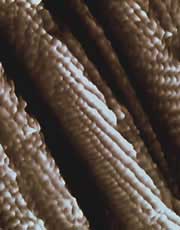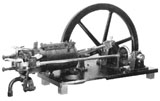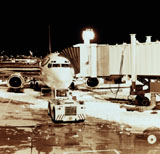The majority of Earth’s water is unfit for human consumption since it is trapped in salty oceans. Although desalination plants are capable of turning saltwater into freshwater, they usually use a lot of energy. Scientists have now created a novel, sponge-like substance that effectively turns saltwater into drinkable water when combined with sunlight and a basic plastic cover. Their research, which was published in ACS Energy Letters, shows that an outdoor proof-of-concept that used just natural sunlight to successfully produce…

The days of fast-fading cellular phone batteries may soon be over. Researchers at the Lawrence Livermore National Laboratory (LLNL) recently developed a working prototype for a portable fuel cell energy source that could power a cellular phone 300 percent longer than existing rechargeable batteries do. Indeed, the new technology would be less expensive, smaller and more powerful than any battery currently in use, according to Jeff Morse of LLNL’s Center for Microtechnology Engineering. He predic

France launches in Valenciennes a 6,4 million euro research program on transport safety. It reinforces the international position of Nord-Pas de Calais and the University of Valenciennes.
The scientific council of the New Research Action “Safety in Transport Systems”, which came together at the University of Valenciennes and Hainaut-Cambrésis on the 31st of January 2002, has just validated and launched a program composed of 7 projects stretched out until 2006. 6,4 million euros will b

The phrase `rain stopped play` is gloomily familiar to fans of Wimbledon, international cricket test matches and other major sporting tournaments.
But cancelling matches because the pitch is waterlogged could be consigned to history, thanks to new technology which could revolutionise the international world of both professional and amateur sport.
Researchers at the University of Newcastle upon Tyne are starting trials involving a completely new concept – Electrokinetic Geosynthetic

Match up folds to fight stubborn paper.
No road journey is complete without a wrestle with the map. Now a US computer scientist has worked out why the map usually wins.
Erik Demaine of the Massachusetts Institute of Technology in Cambridge has come up with an origami algorithm that predicts when a stubborn street plan will be re-foldable. “It’s the meeting of paper folding and computer science,” he says.
The rules governing whether a sheet of paper divided into a g

A computerised navigation system has been developed to enable wheelchair users to select the most accessible routes around a town centre. It means a journey can be planned that avoids obstacles like cobbled streets, steep areas and steps.
The work has been carried out by a team led by Professor Hugh Matthews, at University College Northampton, with funding from the Swindon based Engineering and Physical Sciences Research Council.
The ‘Wheelyroute’ system, believed to be the first

From cutlery and cooking pans to the inside of a Formula 1 car engine or a huge chemical process plant, stainless steel is all around us. It’s not meant to corrode, but it can, and when it does the results can be disastrous, whether it’s a hole in your dishwasher or a failed industrial plant.
Unlike rusting, stainless steel corrosion is highly localised and apparently random. Tiny holes called pits can drill through a substantial thickness of steel in a relatively short time. The pits can ca

Scientists continue to create new uses for carbon nanotubes, those tiny cylinders comprised of pure carbon. A paper published today in the journal Nature describes a thermometer made out of a column of carbon just 10 micrometers long. According to the report, the nanodevice can measure temperatures between 50 and 500 degrees Celsius and “should be suitable for use in a wide variety of microenvironments.”
Yihua Gao and Yoshio Bando of the National Institute for Materials Science in Ibaraki,

Today`s machines produce paper so rapidly that visual quality control is stretched to its limits. New automated systems with cameras and image analysis algorithms manage this flood of paper with no problem – they can even tackle the job with patterned wood and textiles.
The fastest papermaking machine in the world produces a roll of paper approximately 10 meters wide at the rate of 100 kilometers per hour. In less than 20 seconds the paper would cover an area the size of a soccer field. Impo

The use of halogenated flame retardants in plastics is steadily declining because they are volatile, pose an environmental risk and are difficult to recycle. Microcapsules, fibers and melamine resin foams represent some of the chief alternatives.
As successfully as the endless variety of plastics have established themselves on the market, these multifaceted materials show another face when it comes to fire. They melt and feed the flames like the petroleum from which they were ultimately pro

Oxygen and light can alter the taste of foodstuffs. Manufacturers of packaging materials therefore try to protect contents from their influence. The latest approach is to use natural dyes in transparent plastic wrappers that selectively filter light.
Light and oxygen adversely affect the quality of most foodstuffs. In combination they cause various ingredients to undergo photo-oxidation. Fatty food substances become rancid and milk products develop an unpleasant “light-induced” taste. Certai

Carbon nanotubes assemble themselves into electronic grids
Tiny electrical circuits with a single molecule for each wire have been created in the United States 1 . These grids could replace silicon chips, making computers and memory devices much more compact and powerful than they are today.
The grids comprise carbon nanotubes – long, hollow cylinders of pure carbon a few millionths of a millimetre (nanometres) across and several thousand nanometres long. Dep

A quantum afterburner extracts laser light from vehicle exhaust.
The hot gases belching out of your car’s exhaust are not just useless waste. They are a laser waiting to happen, says physicist Marlan Scully1.
All you need to harness this potential, suggests Scully, of Texas A&M University in College Station, is a quantum afterburner. This hypothetical modification would use quantum mechanics to boost the engine’s efficiency by clawing back waste heat and turning it

Every citizen dreams of spending less time in traffic jams, away from polluted air, while continuing to enjoy the same level of mobility and quality of life as today. On Thursday, 31 January, Commissioner for Research Philippe Busquin will participate in the conference “Towards Sustainable Urban Mobility” jointly organised by the European Commission and the European Parliament. The objective of this Conference is to present a network of ten projects in the field of land use and transport funded unde

Controversies over new airport runways make locals more noise-sensitive.
Public controversy surrounding the impending building of a runway may make locals much more sensitive to increased aircraft noise than planners predict. A new study warns that it could be easy to underestimate the impact of changes such as those proposed for Britain’s Heathrow Airport.
A new runway began operating at Vancouver International Airport in 1996 after highly publicized local objection to

Sensors and loudspeakers reduce in-car racket.
Tired of shouting to your passenger as you drive, striving to make your voice heard over the rumble of the car? Help is on the way, in the form of strategically placed sensors and loudspeakers.
Researchers at the Korea Advanced Institute of Science and Technology (KAIST) in Taejon have developed a prototype system that shaves up to 6 decibels off the typical motoring noise of around 60 decibels. That’s more than any other co

Like silicon, silicon carbide is semiconductor and in some aspects, its characteristics are even better. Electrical strength of silicon carbide is ten times higher than that of silicon, heat conductivity is three times higher. Crystals of silicon carbide are almost perfect for power electronics. They can work at high current density (more than 10 kA per square centimeter) and voltage up to 4.5 kV, unachievable for silicon. Moreover, charge-drift velocity is twice higher in silicon carbide providing b